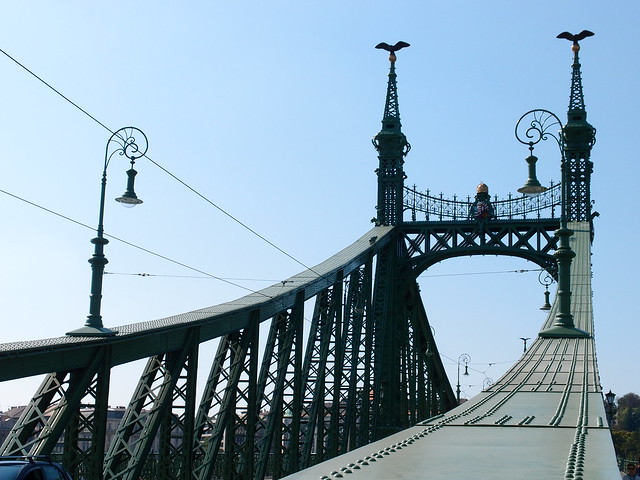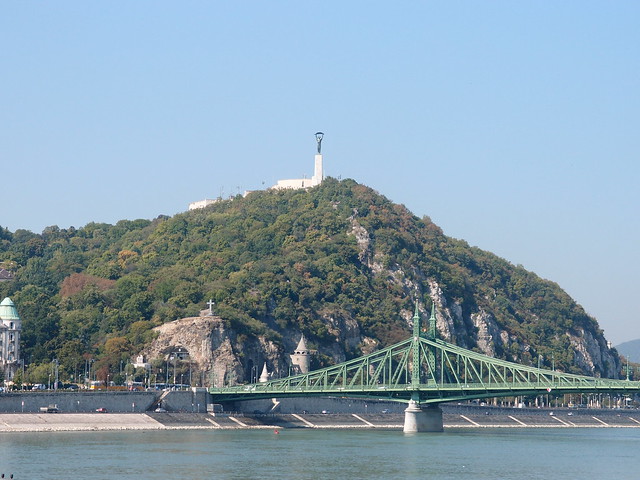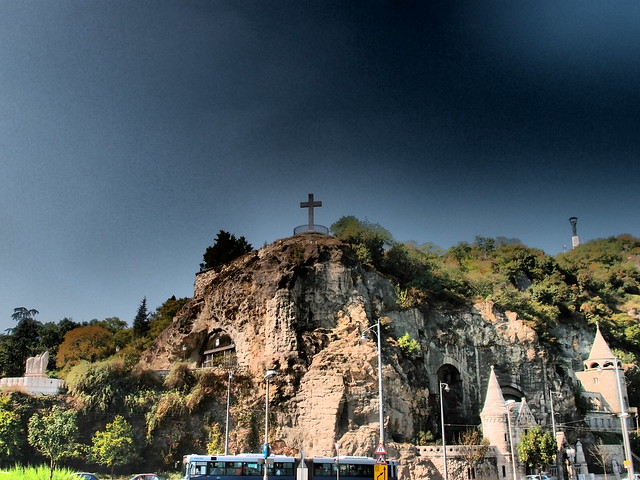After a night in a hostel’s dorm bed and an early-morning
slog to the bus station, the Malev jet gets me to Budapest in the early
afternoon. I don’t know very much about Budapest, other than a vague historic
background, the fact that it’s two cities separated by a river, and that one of
the cities is hilly. The one cultural experience I’ve had of it beforehand is a
movie about Budapest’s subway ticket checkers, which does not paint a pretty
picture of that metropolis’s underground system. My first experience with
Budapest supports that impression. I opt for public transport to reach the city
itself, but while the airport’s international terminal is new and impressive,
it doesn’t have a direct rail connection yet; there’s a local bus connecting it
to the end of the subway terminal. I try the ticket machines, but they won’t
accept my forints; the bus driver won’t take my money either, which is a plus.
On the minus side, the old bus meanders down the highway and spits me out in a
marketplace right out of Tallinn’s difficult Nineties. The unsightly,
graffitied communist-era train carries me to the outer edges of the old
imperial city and my hotel.
There is a word for both Budapest and Vienna; I haven’t been
to Prague, so I don’t know if it applies to the third Hapsburg capital, but it
certainly does to every other major city of that domain. You can still see
references to it on old buildings: K+K, Kaiserlich und Königlich. “Imperial and Royal” refers to
the notion that the monarch ruled at once as the emperor of Austria, and the
king of Hungary; it is an artifact of the unusual political arrangement that
followed the realization that the metaphorical Huns could no longer effectively
govern their lands without the stakeholding involvement of the self-proclaimed
ones. It is that period of Hungary’s greatest significance and prosperity that
dominates the center of Budapest, and I get a strong dose of K+K glory as I
exit the subway station at the intersection of the outer boulevard ring and a
major urban artery. The traffic intersection is absolutely massive. The
Hapsburgs pioneered this architecture in Vienna for the purposes of controlling
rebellions – giving the mob a nice wide road to charge down, into the face of
cannon fire. In Budapest, this aesthetic – perhaps reinforced by the Communist
penchant for monumental civic works – was taken to the extreme. These are not
the broad freeways of LA, designed with traffic flow in mind; first and
foremost, these streets were built to impress.
I drop off my bags at a cheap hotel, cringe at the smell of
smoke in my room, and head back out. I woke up early that morning, with a beer
headache, and didn’t care for the hostel’s communal shower; but Budapest
beckoned, so I throw on a black shirt over my slept-in T-shirt and go down to
the Danube.
The massive river impresses. I walk along the embankment,
north from the last of the downtown bridges described in my guidebook – a Rick
Steves one, which I had never tried before (but I’d been burned a few times
already by terrible Lonely Planet and Rough Guides ones). I check the map to
build a sequence of interesting spots that I want to see, and soon cross a
bridge to one of Budapest’s lesser-known but more impressive landmarks: the
Church in the Rock. Built literally into the side of a steep Buda mountain, it
served as a refuge for the country’s clerics in the Second World War, among
other things.
I love churches, despite being an atheist – they are
frequently the expression of an era and a community’s greatest enduring
achievements. I’ve been to two of the top three Catholic cathedrals in the
world (St. Peters in Rome and St. Johns in New York – the other one is in Cote
D’Ivoire, which will have to wait), but the Church in the Rock is one of the
most literally impressive ones I’d ever visited. It’s the one I remember.
Instead of heading back to the hotel for a shower, I decide to press on, into the Buda hills. Drenched in sweat, I take the steepest paths up from river-level to the Lady with the Bottle Opener – a monument right next to a massive fortress overlooking the city. The Citadel itself costs money to enter; I don’t bother – the beauty is in the view. I go down the other side of the hill and up again, follow my guidebook for a quick run through the grounds of the royal palace, and reach the blessed cool of another unusual attraction – the Hospital in the Rock. This was another WWII sanctuary, a working hospital this time, and now a museum showing the equipment of the age. The medical technology available to German troops so long ago is impressive, but it’s always a bit weird to learn about the struggles of the people who were on the losing side of that war. I may share the Hungarians’ historic dislike of the Soviets, but there’s no doubt that the Nazis were the bad guys in the conflict. The Buda hills were the last part of the city to fall to the Red Army, after a long siege, and things got pretty bad down there in the hospital.
 |
| Travelcat in Budapest |
I cross the hill again and go down through the Fishermen’s
Gate. Checking the guidebook, I go for dinner at a legendary but non-fancy
local eatery, with an unpronounceable name that translates as Grandma’s
Pancakes. It is cheap and delicious, and to my delight, the staff does not
speak English and is not bothered by that. This may be a Nordic bias, but the
most surprising thing about Hungary to me was the fact that in this large
country that is definitely oriented towards Europe, would be very upset if you
thought of it as Balkan, and wants very little to do with the resurgence of
Turkey, hardly anybody speaks English.
Outside the most obvious tourist traps, this society is remarkably
self-contained.
By the time I get out of the café, it is dark – and I
instantly encounter the remarkable sight of the Hungarian Parliament at night.
Viewed in full illumination from across the river, it is a sight that can challenge
any famous urban landscape you care to name, and have a very good chance of
winning.
I walk back along the embankment, on the Pest side, stopping
to take pictures along the way – including the obligatory shot of one of the
central bridges, so iconic that even on a Tuesday evening, there is an
encampment of shutterbugs in the traffic island at its one end, tripods and
all. The cities of Buda and Pest have been here for a very long time, and the
importance of the Danube as a trade route has kept them busy – but for the
longest time, there were no bridges at all. You could cross by boat in the
summer, or walk or ride across the ice in the winter, but there were still long
periods when the two sides were effectively isolated. It was not until fairly
recently that a Hungarian noble prince, stranded on the wrong side and unable
to get to his dying father’s bedside, took up a collection and erected the
first permanent span.
Since then, Budapest’s bridges have joined its castles as
tributes to the nation’s grandeur. These are the most Kaiserlich and Königlich bridges you’re likely to
find.






No comments:
Post a Comment